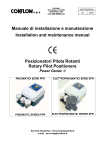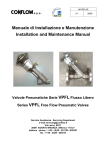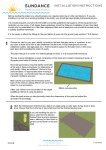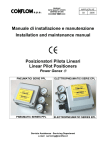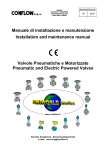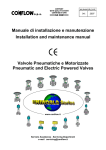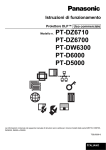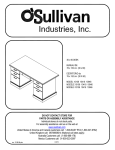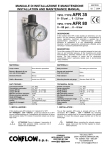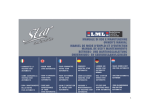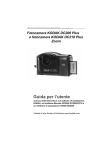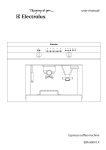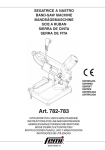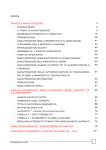Download Conflow S.p.A.
Transcript
M/RP13RP300/I/E 10 2009 MANUALE DI INSTALLAZIONE E MANUTENZIONE INSTALLATION AND MAINTENANCE MANUAL RIDUTTORE DI PRESSIONE AUTOAZIONATO TIPO RP 13 TIPO RP 300 SELF-ACTING PRESSURE REDUCING VALVE TYPE RP 13 TYPE RP 300 Servizio Assistenza - Servicing Department e-mail [email protected] INDICE INDEX Pag. Page 1 INFORMAZIONI GENERALI 1 1 GENERAL INFORMATIONS 1 1 2 ISTRUZIONI DI MONTAGGIO 1 2 INSTALLATION INSTRUCTIONS 1 2.1 MONTAGGIO SULL’IMPIANTO 2 2.1 INSTALLATION IN THE PLANT 2 2.2 AVVIAMENTO 3 2.2 START-UP 3 3 ISTRUZIONI DI MANUTENZIONE 4 3 MAINTENANCE INSTRUCTIONS 4 3.1 SOSTITUZIONE DEL GRUPPO MEMBRANA-PIATTO MEMBRANA 4 3.1a DIAPHRAGM AND DIAPHRAGM PLATE SET REPLACEMENT 4 3.2 SOSTITUZIONE DELLA MEMBRANA 4 3.2 DIAPHRAGM REPLACEMEN 4 4 ELENCO COMPONENTI CON RIFERIMENTI 5/6 4 COMPONENTS LIST WITH REF. 5 ANOMALIE DI FUNZIONAMENTO 7 5 TROUBLES SHOOTING 7 6 ANALISI DEI RISCHI 8 6 HAZARDS ANALYSIS 8 7 7.1 7.2 DICHIARAZIONI DI CONFORMITA’ STANDARD PED 97/23/CE Mod.A / Vapore / RP13 / PN 16 Mod.A / Vapore / RP13 / PN 40 7 7.1 7.2 STANDARD DECLARATIONS OF CONFORMITY PED 97/23/CE Mod.A / Steam / RP13 / PN 16 Mod.A / Steam / RP13 / PN 40 5/6 1 - INFORMAZIONI GENERALI DI SICUREZZA ! 1 – GENERAL AND SAFETY INFORMATION ! ATTENZIONE ! WARNING ! A) Prima di installare la valvola rimuovere le protez ioni di plastica poste a copertura delle flange o degli attacchi di connessione. A) Before installing valve, remove plastic covers placed on flanges or connection ends. B) prima di installare la valvola assicurarsi che il campo della pressione ridotta sia quello desiderato. B) Before installing valv e, check that the spring pressure range is as required. C) Attenz ione! durante la messa in funz ione della valvola o durante l’esercizio non toccare il gruppo corpo che potrebbe condurre calore se il fluido impiegato è ad alta temperatura. C) Warning! When a valve is started, or during w orking operation, do not touch its body because it may conduct heat if the used fluid is at high temperature. D) Attenzione! Prima di iniz iare eventuali operaz ioni di manutenzione assicurarsi che la valvola non sia in pressione e/o calda. D) W arning! Before starti ng maintenance be sure that the valve is not pressurized or hot. E) Non rimuovere la targhetta descrittrice fissata alla colonna poiché riporta il numero di matricola, dato indispensabile per rintracciare la valvola nel tempo. Si prega di fare espresso riferimento a tale numero per la fornitura di parti di ricambio. E) Do not remove description plate attacched to valve yoke: valve serial number is stamped on it. Always refer to such number w hen ordering spare parts or for servicing. La mancata osservanz a delle informaz ioni generali di sicurezza, delle norme vigenti e delle istruzioni di montaggio possono: In the event of non-observ ance of the general rules, safety informations and of the installation instructions, this may: Cause danger to life and limb of the user or third party Damage the valves and other property belonging to the owner Endanger the efficient functioning of the valves Causare pericolo per l’ incolumità di chi sta eseguendo le manovre o di terzi Danneggiare la stessa valvola o le cose adiacenti Compromettere l’ efficiente funz ionamento della valvola stessa 2 - ISTRUZIONI DI MONTAGGIO 2 - INSTALLATION INSTRUCTONS Le seguenti istruz ioni, con riferimento allo schema n°VR 100, riguardano il montaggio sull’ impianto del riduttore di pressione autoazionato tipo RP13 /RP300 : The following instructions, with reference to the installation sketch n° VR 100, cover the plant installation of type RP13/RP300 self-acting pressure reducing valve: Prima del montaggio della valvola effettuare un accurata puliz ia della tubaz ione con aria compressa, acqua o altro fluido di soffiaggio per eliminare corpi estranei scorie di saldatura e detriti vari che potrebbero danneggiare le superfici di tenuta della valvola. Before installing the valve, clean pipes accurately w ith compressed air, water or other suitable blowing fluids to eliminate foreign matters, slag or debris w ich may demage the seal surfaces of valve. Montare la valvola con la freccia di direz ione impressa sul corpo nello stesso senso del fluido della tubazione. Compatibilmente con il diametro della valvola viene comunque raccomandato il montaggio di un filtro a “Y” tipo FY 16 opp. FY 40 (rif.34) a monte della valvola. When installing the valve, ensure the direction arrow printed on its body is in the same direction as the pipe fluid. Com patibly w ith the valve di ameter, it’ s however raccomended to install a “Y” filter type F Y 16 or F Y 40 (ref. 34) upstream of the valve. Quando la valvola è utiliz zata su vapore deve essere sempre installata verticalm ente con la testata in basso, mentre quando è utiliz zata su liquidi, aria o gas non corrosivi può essere installa ta verticalmente sia con la testata in basso che con la testata in alto. Install the valve vertically w ith diaphragm actuator downwards w hen it is used for steam service, w hile when it is used for liquid, air or non corrosive gases services, the valve can be installed either w ith diaphragm actuator upwards or downwards. ! ATTENZIONE E’ vietato gravare la WARNING External loads cannot valvola con carichi estranei. E’ obbligo dell’installatore proteggere la valvola da sollecitazioni esterne. ! 1 be applied to the valve. The installer must take appropriate special measures to protect the valve from external stress. 2.1 - MONTAGGIO SULL’IMPIANTO 2.1 - INSTALLATION IN THE PLANT Quando la valvola è utiliz zata su vapore , una barriera d’acqua deve essere interposta tra il vapore e la membrana di gomma della test ata, pertanto un barilotto (rif.32) deve essere sempre installato tra la presa d’impulso (localiz zata sulla mez zeria inferiore della tubazione a valle a circa 1 metro di distanz a dalla flangia di uscita della valvola) e la testata : When the valve is used for steam service a w ater barrier must be realiz ed between the steam and the rubber diaphragm, therefore a condensation pot (ref. 32) must be always installed between the outlet impulse (located in the middle of dow nstream pipe a 1 meter of distance far from the outlet flange of the valve) and the diaphragm actuator : - Collegare la presa d’ impulso con l’apposito attacco filettato (rif. A) del barilotto usando tubo di rame o di acciaio. - Connect the outlet impulse to the screw ed connection (ref. A) of condesation pot by means of copper or steel tube. - Collegare l’ attacco filettato (rif. B) del barilotto con l’apposito attacco filettato (rif. 33) della testata usando tubo di rame o di acciaio senz a interporre alcuna valvola di intercettazione. - Connect the screw ed connection (ref. B) of condensation pot to the screwed connection (ref. 33) of the diaphragm actuator by means of copper or steel tube without any isolating valve. - Utiliz zare l’ attacco filetta to (rif. C) per mettere acqua nel barilotto (rif. 32), aprire lo sfiato (rif. 2) della testata al fine di eliminare eventuali sacche d’ aria contenute nella stessa. - Use the screw ed connection (ref. C) to put water into the condensation pot (ref. 32) , opening the airvent (ref. 2) of the diaphragm actuator during the filling operation. - Chiudere la vite di sfiato (rif. 2) della testata. - Close the airvent (ref. 2) of the diaphragm actuator. - Chiudere l’ attacco filettato del barilotto (rif. C) usando l’apposito tappo, incluso nel KIT di montaggio per vapore (codice KIT). - Close the screw ed connection (ref. C) of the condensation pot, by means of the suitable plug included into the mounting kit for steam (code KIT). OPPURE OR Quando la valvola è utiliz zata su liquidi, aria o gas non corrosivi, collegare semplicemente la presa d’ impulso (localizzata sulla tubaz ione a valle) con l’apposito attacco filettato (rif. 33) della testata, usando tubo di rame o di acciaio e senz a interporre alcuna valvola di intercettazione : When the valve is used for liquid, air or non corrosive gases service, simply connect the outlet impulse (located on dow nstream pipe) to the screwed connection (ref. 33) of the diaphragm actuator by means of copper or steel tube and without any isolating valve : - Assicurarsi che la vite di sfiato (rif. 2) della testata sia chiusa dopo le operaz ioni di disaeraz ione della testata stessa (nel caso di impieghi su liquidi). - Make sure the air vent (ref. 2) of the diaphragm actuator is closed after air draining operation of diaphragm actuator itself (for liquid application). Se si desidera avere un funz ionamento continuo dell’impianto anche durante la manutenz ione o la sostituzione della valvola, è consigliabile prevedere un adeguato by-pass (rif. 34) con relative valvole di intercettazione manuali (rif. 34). If continuous operation of the plant is required even during maintenance or replacement of the valve, it is recommended a proper by-pass (ref. 34) with appropriate isolating valves (ref.34). E’ sempre raccomandabile l’ installazione di un manometro (rif. 36) sia a monte che a valle della valvola. It is recommended that a pressure gauge (ref. 36) be installed always upstream and downstream of the valve. Una valvola di sicurezza PED 97/23/CE. (rif. 37) deve essere sempre montata per soddisfare i requisiti e le norme di sicurezza. A safety valv PED 97/23/CEe (ref. 37) must be fitted to meet safety requirements. 2 2.2 - AVVIAMENTO 2.2 - START - UP Quando la valvola è installa ta e sono stati eseguiti correttamente tutti i collegamenti, procedere all’avviamento del riduttore come segue : When the valve is installed and all connections are properly made, it is brought into operation as follow : Per valvole con testata in basso (applicazione su vapore) For valves with diaphragm actuator downwards (application on steam) Controllare che tutte le valvole di intercettazione (a monte, a valle e by-pass) siano perfettamente chiuse. Check that all isolating valves (upstream, dow nstream and by-pass) are perfectly closed. Ruotare completamente, in senso antiorario, la ghiera di regolazione (rif. 20) finchè la molla (rif. 15) risulti priva di compressione oppure fino al fine corsa della ghiera di regolazione della stessa. Turn fully anti-clockw ise spring adjusting plate (ref. 20) until the spring (ref. 15) is completely released or until the travel end of the spring adjusting plate. Aprire lentamente la valvola di intercettaz fino alla completa apertura. Open slow ly dow nstream isolat ing valve until it is fully opened. ione a valle Aprire lentamente la valvola di intercettaz ione a monte fino alla completa apertura. Open slow ly upstream isolati ng valve until it is fully opened. Ruotare lentamente, in sens o orario, la ghiera di regolazione (rif. 20) fino ad ottenere sul manometro a valle (rif.36) la pressione desiderata. Turn slow ly spring adjusting plate (ref. 20) in an clockwise direction until dow nstream pressure reading is obtained on pressure gauge (ref. 36). Per variare la pressione di taratura, ruotare la ghiera regolazione (rif. 20) in senso orario od antiorario rispettivamente per aumentare o diminuire la pressione a valle. To change the setting turn the spring adjusting plate (ref. 20) clockwise or anti-clockw ise respectively to increase or decrease the downstream pressure. Per valvole con testata in alto (applicazione su liquidi, aria o gas non corrosivi) For valves with diaphragm actuator downwards (application for liquid, air or non-corrosive gases) Controllare che tutte le valvole di intercettazione (a monte, a valle e by-pass) siano perfettamente chiuse. Check that all isolating valves (upstream, dow nstream and by-pass) are perfectly closed. Ruotare completamente, in senso orario, la ghiera di regolazione (rif. 20) finchè la molla (rif. 15) risulti priva di compressione oppure fino al fine corsa della ghiera di regolazione della stessa. Turn fully clockwise spring adjusting plate (ref. 20) until the spring (ref. 15) is completely released or until the travel end of the spring adjusting plate. Aprire lentamente la valvola di intercettaz fino alla completa apertura. Open slow ly dow nstream isolat ing valve until it is fully opened. ione a valle Aprire lentamente la valvola di intercettaz ione a monte fino alla completa apertura. Open slow ly upstream isolati ng valve until it is fully opened. Ruotare lentamente, in senso antiorario, la ghiera di regolazione (rif. 20) fino ad ottenere sul manometro a valle (rif.36) la pressione desiderata. Turn slow ly spring adjusting plate (ref. 20) in an anti-clockwise direction until downstream pressure reading is obtained on pressure gauge (ref. 36). Per variare la pressione di taratura, ruotare la ghiera regolazione (rif. 20) in senso orario od antiorario rispettivamente per diminuire o aumentare la pressione a valle. To change the setting turn the spring adjusting plate (ref. 20) clockwise or anti-clockw ise respectively to decrease or increase the downstream pressure. 3 SCHEMA N° VR 100 SKETCH N° VR 100 3 - ISTRUZIONI DI MANUTENZIONE 3 - MAINTENANCE INSTRUCTIONS 3.1 - SOSTITUZIONE DEL GRUPPO MEMBRANA PIATTO MEMBRANA 3.1 - DIAPHRAGM AND DIAPHRAGM PLATE SET REPLACEMENT Togliere il raccordo dall’attacco della testata (rif. 33). Take off fitting from the screw ed connection (ref. 33) of the diaphragm actuator. Loosen nuts and bolts (ref. 5-6) and take off the upper actuator casing (ref.1). Allentare dadi e bulloni (rif. 5superiore (rif. 1). 6) e togliere la testata Ruotare completamente in senso orario, per valvole con testata in basso, oppure in s enso antiorario, per valvole con testata in alto, il piattello (rif. 8) con montata la membrana (rif. 7). Turn fully clockw ise, for valves w ith diaphragm actuator downwards, or anti-clockw ise, for valves w ith diaphragm actuator upw ards, the diaphragm plate (ref. 8) with assembled diaphragm (ref. 7). Montare il nuovo piattello con la nuova membrana. Assemble the diaphragm plate with the new diaphragm. Per il rimontaggio proceder e all’ inverso prestando particolare attenzione di avvitare completamente il piattello (rif. 8) sullo st elo (rif. 17) fino al fermo meccanico. For reassembling, carry out the above procedure in reverse taking care to turn of the diaphragm plate (ref. 8) until it is fully blocked on the stem (ref. 27) and until the mechanical stop. Riavvitare il raccordo all’ attacco filettato (rif.33) della testata superiore. Restore the fitting to the screwed connection (ref. 33) of the upper actuator casing. 3.2 - SOSTITUZIONE DELLA MEMBRANA 3.2 - DIAPHRAGM REPLACEMENT Procedere come descritto nei precedenti paragrafi 3.1a e 3.1b finchè la testata superiore (rif. 1) è stata tolta. Proceed as above points 3. 1a and 3.1.b until the upper diaphragm casing (ref. 1) has been taken off. Tenere fermo il piattello (rif. 8), allentare il dado (rif. 3), togliere la rondella (rif. 4) e la vecchia membrana (rif. 7). Keeping diaphragm plate (ref. 8) fixed, loosen nut (ref. 3), take off w asher (ref. 4) and the old diaphragm (ref. 7). Montare la nuova membrana. Assemble the new diaphragm. Per il rimontaggio procedere all’ inverso e ripristinare il raccordo nell’ attacco filettato (rif. 33) della testata superiore. For reassembling, carry out the above procedure in reverse and finally restore the fitting to the screw ed connection (ref. 33) of the upper actuator casing. 4 TIPO RP13 / TYPE RP13 4- ELENCO COMPONENTI CON RIFERIMENTI Components list with ref. 1) TESTATA SUPERIORE Upper diaphragm casing 2) VITE DI DISAREAZIONE Airvent 3) DADO DI BLOCC. MEMBRANA Hexagonal locknut 4) RONDELLA MEMBRANA Washer 5) VITI SERRAGGIO TESTATA Diaphragm casing bolts 6) DADI SERRAGGIO TESTATA Diaphragm casing locknuts 7) MEMBRANA Diaphgragm 8) PIATTELLO Diaphragm plate 9) TESTATA INFERIORE Lower diaphragm casing 10) ROSTRO Lower spring plate 11) GRANO DI BLOCCAGGIO Grub screw 12) BUSSOLA CORTECO Airtight guide 13) O-RINGS (DN 25 - DN 50) O-rings (DN 25 - DN 50) 14) CORTECO Airtight 15) MOLLA Spring 16) COLONNA Yoke 17) STELO Stem 18) FONDELLO PORTA MOLLA Upper spring plate 19) CUSCINETTO A SFERA Ball bearing 20) GHIERA DI REGOLAZIONE Spring adjusting plate 21) DADI SERRAGGIO CORPO Body locknuts 22) PRIGIONIERI Stud-bolts 23) BUSSOLA DI GUIDA Guide bushing 24) GUARNIZIONE CORPO Body gasket DN 25 - DN 100 DN 15 - DN 20 25) GHIERA BLOCC. OTTURATORE Plug locknut 26) NOTTOLINO OTTURATORE Entering catch 27) OTTURATORE Plug 28) CORPO Body 29) SEDE Seat 30) RONDELLA DI OTTONE (DN 15 - DN 20) 31) SEEGER Washer (DN 15 - DN 20) Seeger (DN 15 - DN 20) 5 TIPO RP300 / TYPE RP300 4- ELENCO COMPONENTI CON RIFERIMENTI Components list with ref. 1) TESTATA SUPERIORE Upper diaphragm casing 2) VITE DI DISAREAZIONE Airvent 3) DADO DI BLOCC. MEMBRANA Hexagonal locknut 4) RONDELLA MEMBRANA Washer 5) VITI SERRAGGIO TESTATA Diaphragm casing bolts 6) DADI SERRAGGIO TESTATA Diaphragm casing locknuts 7) MEMBRANA Diaphgragm 8) PIATTELLO Diaphragm plate 9) TESTATA INFERIORE Lower diaphragm casing 10) ROSTRO Lower spring plate 11) GRANO DI BLOCCAGGIO Grub screw 12) BUSSOLA CORTECO Airtight guide 13) O-RINGS (DN 25 - DN 50) O-rings (DN 25 - DN 50) 14) CORTECO Airtight 15) MOLLA Spring 16) COLONNA Yoke 17) STELO Stem 18) FONDELLO PORTA MOLLA Upper spring plate 19) CUSCINETTO A SFERA Ball bearing 20) GHIERA DI REGOLAZIONE Spring adjusting plate 21) DADI SERRAGGIO CORPO Body locknuts 22) PRIGIONIERI Stud-bolts 23) BUSSOLA DI GUIDA Guide bushing 24) GUARNIZIONI CORPO Body gaskets DN 25 - DN 100 DN 15 - DN 20 25) GHIERA BLOCC. OTTURATORE Plug locknut 26) NOTTOLINO OTTURATORE Entering catch 27) OTTURATORE Plug 28) CORPO Body 29) SEDE Seat 30) RONDELLA DI OTTONE (DN 15 - DN 20) 31) SEEGER Washer (DN 15 - DN 20) 32) FLANGIA DI CHIUSURA Lower flange 33) DADI SERRAGGIO FLANGIA INFERIORE Lower flange locknuts Seeger (DN 15 - DN 20) 6 5 - ANOMALIE DI FUNZIONAMENTO Riportiamo qui di seguito alcuni inconvenienti che valvole ed i provvedimenti da adottare. INCONVENIENTI RISCONTRATI La valvola rimane aperta e non riduce si possono verificare durante il funzionamento delle CAUSA PROVVEDIMENTO membrana forata sostituire la membrana perdita d’aria nella testata stringere le viti perimetrali della testata rimuovere i depositi ricercare le cause nella presa di impulso depositi di scorie nel corpo valvola la presa di impulso è otturata Movimento a strappi dello stelo stelo corroso o grippato sostituire lo stelo sedimenti nella camera di tenuta sostituire le tenute dello stelo Perdita elevata con valvola chiusa tenuta metallica rovinata - il cono smerigliare o sostituire l’otturatore, dell’otturatore o lo spigolo della smerigliare o tornire il piano della sede rovinato sede Perdita del premistoppa “O” rings e / o anelli deteriorati sostituire gli “O” rings e gli anelli 5 - TROUBLES SHOOTING Herebelow some of the possible causes giving troubles during normal working conditions of the valves and the direction to follows in order to find the source of them : SYMPTOMS POSSIBLE CAUSE The valve remain closed without reduction. REMEDY actuator diaphragm perforated replace the actuator diaphragm air leaks in the actuator tight bolts and nuts of diaphragm casings remove them and clean the seating check the outlet impulse connection and the tube foreign material inside the body The outlet impulse is shut Trigger action of the stem High leakage of fluid through valve in closed position Leakage on stuffing box corroded or seized stem foreign material inside the bonnet the metal seating, plug seat are damaged metal seating, plug seat are damaged “O” rings and / or damaged 7 shape shape replace the stem replace the stuffing box packing or lap lap or lap lap or or or or replace the plug, face the surface of the seat replace the plug, face the surface of the seat rings are replace the “O” rings and rings the 6 – ANALISI DEI RISCHI 6 – HAZARDS ANALYSIS Con questo documento vengono valutati i rischi connessi con l’ apparecchiatura su indicata, che possono insorgere durante il suo utilizzo, installazione o movimentaz ione, in accordo a quanto previsto dalla Direttiva PED 97/23 CE Allegato 1 punto 1 e 2, vengono altresì indicate le prescrizioni a cui attenersi per evitare l’ insorgere degli stessi. Analysis of hazards that ma y occur during normal w orking, installation and maintenance. In line with what is required by PED Directive 97/23/CE A nnex 1 points 1 & 2 the manufacturer must follow the principles set out below in the following order to arrive at the most appropriate solution: La classificazione delle soluzioni adottate è la seguente: b) a) b) c) c) soluzione per eliminare e/o ridurre il rischio applicazione delle opportune misure di protez contro i rischi che non possono essere eliminati informazione degli utilizzatori circa i rischi residui CAUSA EFFETTO PERICOLO ione Sovrapressione oltre la massima pressione ammissibile PS Rottura del corpo, cricche, deformazioni permanenti Proiezioni di parti metalliche, fuoriuscita del fluido a) Il corpo valvola è a) eliminate or reduce haz ards as far as is reasonably practicable apply appropriate protecti on measures against haz ards which cannot be eliminated where appropriate, inform users of residual hazards CAUSE Over-pressure (more than the maximum allowable pressure PS) EFFECT Breaking of body, stress crack, permanent deformations. RISK Discharge of metallic parts, leakage of fluid. costruito con i a) The valve body is properly designed taking in account appropriate safety coefficients assured by the calculation method. b) The plant must be equipped w ith the appropriate safety equipments if are provided by PED Directive or by other countries rules dovuti margini di sicurezza SOLUZIONE CAUSA EFFETTO PERICOLO b) L’impianto deve essere dotato degli accessori di sicurezza qualora le Direttive e/o Normative in vigore li prevedono c) In targhetta è riportata la massima pressione ammissibile SOLUTION c) On the identification plate is written the max allow able pressure. Surriscaldamento (oltre la massima temperatura ammissibile TS) Sovrapressione interna CAUSE EFFECT Rottura o deformaz ione del corpo, RISK fuoriuscita del fluido a) Il corpo valvola è costruito con i dovuti margini di sicurezza. b) L’impianto deve essere dotato di idonei dispositivi di controllo, contro il superamento della temperatura impostata. SOLUZIONE c) La temperatura massima è dichiarata sulle ns. specifiche tecniche e deve essere controllata da chi dimensiona e/o sceglie la valvola. 8 SOLUTION Over-temperature (more than the maximum allowable temperature TS) Internal over-pressures. Breaking or deformati on of body valve, leakage of fluid. a) The valve body is properly designed taking in account appropriate safety coefficients assured by the calculation method. b) The plant must be equipped w ith appropriate control devices against over-temperature. c) T he maximum allowable temperature TS is declared on our technical leaflets and must be ckeck during the siz ing of the valve. 6 – ANALISI DEI RISCHI CAUSA EFFETTO PERICOLO SOLUZIONE 6 – HAZARDS ANALYSIS Forze di reazione a sollecitazione esterne Deformazione, cedimento strutturale EFFECT Rottura o deformazione del corpo, RISK fuoriuscita del fluido a) È’ vietato gravare la valvola con carichi estranei, è obbligo dell’installatore proteggere la valvola da sollecitazioni esterne. b) Sul manuale sez ione 2, punto 2.1 è prescritto quanto indicato al punto a) e c). c) E’ compito dell’ installatore verificare che l’ apparecchio sia esente da pericoli dovuti a forz e di reazione e/o sollecitazioni esterne. Temperature di esercizio CAUSA EFFETTO Parti metalliche a temperatura elevata PERICOLO Scottature a) SOLUZIONE CAUSE Discharge of metallic parts, leakage of fluid. a) External loads cannot be applied to the valve; the installer must take appropriate special measures to protect the valve from external stresses. b) On present manual section 2, point 2.1 is written what descripted on point a) and c). c) The installer must ensure the valve is fitted w ith suitable accessories to meet damagelimitation requirements in the event of external stress. CAUSE EFFECT RISK b) Apposiz ione da parte dell’utilizzatore di idonea segnaletica di pericolo indicante che le parti possono raggiungere temperature pericolose . Nel manuale è chiaramente prescritto quanto indicato nella presente analisi. di Deformation, structural settling. SOLUTION Installazione in z ona protetta o coibentazione della valvola. c) Coibentaz ione personale. Reaction to external stresses protezione 9 SOLUTION Working temperature High surface temperature. Burns. a) Installation in safe and/or protected places and/or insulation of the equipment. b) Instructions must be affixed to the equipment and also refer to hazards arising from dangerous surface temperatures. c) Insulation for personal protection. 6 – ANALISI DEI RISCHI CAUSA EFFETTO PERICOLO Installazione e/o utilizzo non conforme a quanto prescritto o alle norme vigenti Installazione non appropriata, rottura dell’apparecchio. Cattivo funz ionamento EFFECT Non correct assembling, breaking of valve. c) CAUSE Manutenzione non corretta EFFECT pericolo di proiez ioni di particolari in RISK fuoriuscita del a) Le attività di manutenzione devono essere effettuate con valvola intercettata. b) L’apparecchio deve essere privo di pressione idrostatica. SOLUTION c) L’apparecchio deve essere intercettato com e prescritto nel manuale di uso e installazione. CAUSA EFFETTO PERICOLO Ambiente esterno – carichi addizionali (vento e terremoto non applicabili) Deformazione, cedimento strutturale CAUSE EFFECT Rottura o deformaz ione della valvola, RISK fuoriuscita del fluido a) Sostenere con appositi sostegni tutte le tubaz ioni di collegamento che gravano sulla valvola. b) I carichi sono indicati su richiesta del cliente dal ns. ufficio tecnico commerciale. SOLUZIONE c) applicable On the present manual is at point 1. written Maintenance of the valve with the plant under pressure Incorrect maintenance. dell’impianto, fluido SOLUZIONE of The installer and/ or the user must take the necessary steps to comply with the rules as laid dow n by law and check the compatibility with the used fluids. b) Not Nel manuale d’ uso è prescritto al punto 1. pressione, pericolo di Bad w orking of the plant, leakage fluid. SOLUTION applicabile. Cattivo funz ionamento PERICOLO Installation and/or use not in accordance with directions and/or as laid down by law a) Manutenzione della valvola con impianto in pressione CAUSA CAUSE RISK L’installatore e/o l’ utilizzatore devono informarsi sulle norme vigenti in materia e verificare la compatibilità con i fluidi utilizzati. b) Non c) EFFETTO dell’impianto, uscita dei fluidi. a) SOLUZIONE 6 – HAZARDS ANALYSIS SOLUTION Le strutture di sostegno i bulloni di fondazione e le fondaz ioni debbono essere idonee per tale carico. 10 Bad w orking of the plant, danger of discharge of metallic parts, danger of leakage of fluid. a) The maintenance of the valve must be carried out w ith the equipment at atmospheric pressure. b) The valve must be w hydrostatic pressure. ithout c) The fluids of the equipment be intercepted. must External environment – additional loads - (wind and earthquake not applicable) Deformation, structural settling. Breaking or deforma leakage of fluid. tion of valve, a) Suitable support must be given to all pipew ork to stop any stress on valve. b) Loads are show n on request by our technical-commercial bureau. c) The foundations, bolts and pipework supports must be capable of supporting the w eight of the valve. PED / modA / Vapore / RP13 RP300 / PN16 Via Lecco 69/71 20041 AGRATE BRIANZA (MI) - ITALY DICHIARAZIONE DI CONFORMITA’ AI SENSI DELL’ALLEGATO VII DIRETTIVA EUROPEA “PED” N° 97/23/CE Declaration of conformity according to PED DIRECTIVE N° 97/23/CE annex VII A. Descrizione / Description : Riduttori di pressione Tipo RP13 – RP300 Pressure reducing valves Type RP13 – RP300 Numero/i di matricola / Serial number/s : Vari riportato/i sulla targhetta identificatrice / marked on identification plate da DN 15 A DN 100 Massima pressione ammissibile / Max allowable pressure PS 16 bar materiale ghisa EN GJL 250 B. Fluido Gruppo 2 Group of fluid 2 Articolo 3, punto 1.3 lettera a) e (b), secondo trattino Article 3, Section 1.3 (a) and (b), second indent C. Procedure di valutazione di conformità utilizzata : Conformity Assessment procedures followed : MODULO A (rif. Allegati II e III della Direttiva 97/23/CE) Module A (ref. PED 97/237/CE, annex II and III) Per quanto esposto si dichiara che gli apparecchi descritti ai punti A e B verificati in accordo al punto C, soddisfano i requisiti essenziali di sicurezza previsti nell’allegato I della Direttiva 97/23/CE e ad essa applicabili. We declare that the equipments mentioned on above point A and B, verified according to point C, are conformed to the most essential safety requirements as required by Directive 97/23/CE annex I. CERTIFICATO DI CONFORMITA’. I prodotti sono stati verificati e ispezionati rispetto al nostro Sistema Controllo Qualita' UNI EN ISO 9001. Noi certifichiamo che questo prodotto corrisponde alla Vostra richiesta e che le sue caratteristiche sono in conformita' con le nostre specifiche tecniche. CERTIFICATE OF CONFORMITY This product has been manufactured, tested and inspected in accordance with our Quality Assurance System UNI EN ISO 9001. We certify that it contents correspond to the order placed and its performance is in conformance with our technical specifications. Data di rilascio 05/05/2010 Date of Issue PED / modA / Vapore/ RP13 RP300 / PN40 / ANSI 300 Via Lecco 69/71 20041 AGRATE BRIANZA (MI) - ITALY DICHIARAZIONE DI CONFORMITA’ AI SENSI DELL’ALLEGATO VII DIRETTIVA EUROPEA “PED” N° 97/23/CE Declaration of conformity according to PED DIRECTIVE N° 97/23/CE annex VII A. Descrizione / Description : Riduttori di Pressione Tipo RP13 – RP300 Pressure Reducing Valves Type RP13 – RP300 Numero/i di matricola / Serial number/s : Vari riportato/i sulla targhetta identificatrice / marked on identification plate Tipo/Type RP13 DN 15 - DN 100 Massima pressione ammissibile / Max allowable pressure PS 40 bar materiale acciaio carbonio 1.0619 / Body material carbon steel 1.0619 Tipo/Type RP300 DN 15 - DN 100 Massima pressione ammissibile / Max allowable pressure PS 50 bar materiale acciaio carbonio ASTM A 216 WCB / Body material carbon steel ASSTM A 216 WCB B. Fluido Gruppo 2 Group of fluid 2 Articolo 3, punto 1.3 lettera a) e (b), secondo trattino Article 3, Section 1.3 (a) and (b), second indent C. Procedure di valutazione di conformità utilizzata : Conformity Assessment procedures followed : MODULO A (rif. Allegati II e III della Direttiva 97/23/CE) Module A (ref. PED 97/237/CE, annex II and III) Per quanto esposto si dichiara che gli apparecchi descritti ai punti A e B verificati in accordo al punto C, soddisfano i requisiti essenziali di sicurezza previsti nell’allegato I della Direttiva 97/23/CE e ad essa applicabili. We declare that the equipments mentioned on above point A and B, verified according to point C, are conformed to the most essential safety requirements as required by Directive 97/23/CE annex I. CERTIFICATO DI CONFORMITA’ . I prodotti sono stati verificati e ispezionati rispetto al nostro Sistema Controllo Qualita' UNI EN ISO 9001. Noi certifichiamo che questo prodotto corrisponde alla Vostra richiesta e che le sue caratteristiche sono in conformita' con le nostre specifiche tecniche. CERTIFICATE OF CONFORMITY This product has been manufactured, tested and inspected in accordance with our Quality Assurance System UNI EN ISO 9001. We certify that it contents correspond to the order placed and its performance is in conformance with our technical specifications. Data di rilascio 05/05/2010 Date of Issue Via Lecco 69/71 20041 AGRATE BRIANZA (MI) – ITALY DICHIARAZIONE DI CONFORMITA’ AI SENSI DELL’ALLEGATO II DIRETTIVA EUROPEA “MACCHINE” N° 2006/427CE Declaration of conformity according to “MACHINE DIRECTIVE” N° 2006/42/CE annex II A. Descrizione Tipo / Description Type : Valvole Serie UNIWORLD – Valves UNIWORLD Series Tipo / Type 2000-2100-2200-2300-2400-2600-2700-5000-5100-5200-5300-5400-5600-5700-5800 Riduttori di pressione autoazionati RP 13 – Pressure Reducing Valves Type RP 13 Riduttori di pressione autoazionati RP 300 – Pressure Reducing Valves Type RP 300 Riduttori di pressione autoazionati RP 10 – Pressure Reducing Valves Type RP 10 Valvole Serie HYGIENIC – Valves HYGIENIC Series Tipo / Type 1200-1300-1400-1500-1800 Numero/i di matricola / Serial number/s : Vari / various riportato/i sulla targhetta identificatrice / marked on identification plate B. Procedure di valutazione di conformità utilizzata : Conformity Assessment procedures followed : ALLEGATO VIII - ANNEX VIII Data di rilascio - Date of Issue 26/10/2009 Servizio Assistenza - Servicing Department e-mail : [email protected] Via Lecco, 69/71 20041 AGRATE BRIANZA (Milano) - ITALY telefono - phone : ++39 - (0)39 - 651705 / 650397 fax : ++39 - (0)39 - 654018


















